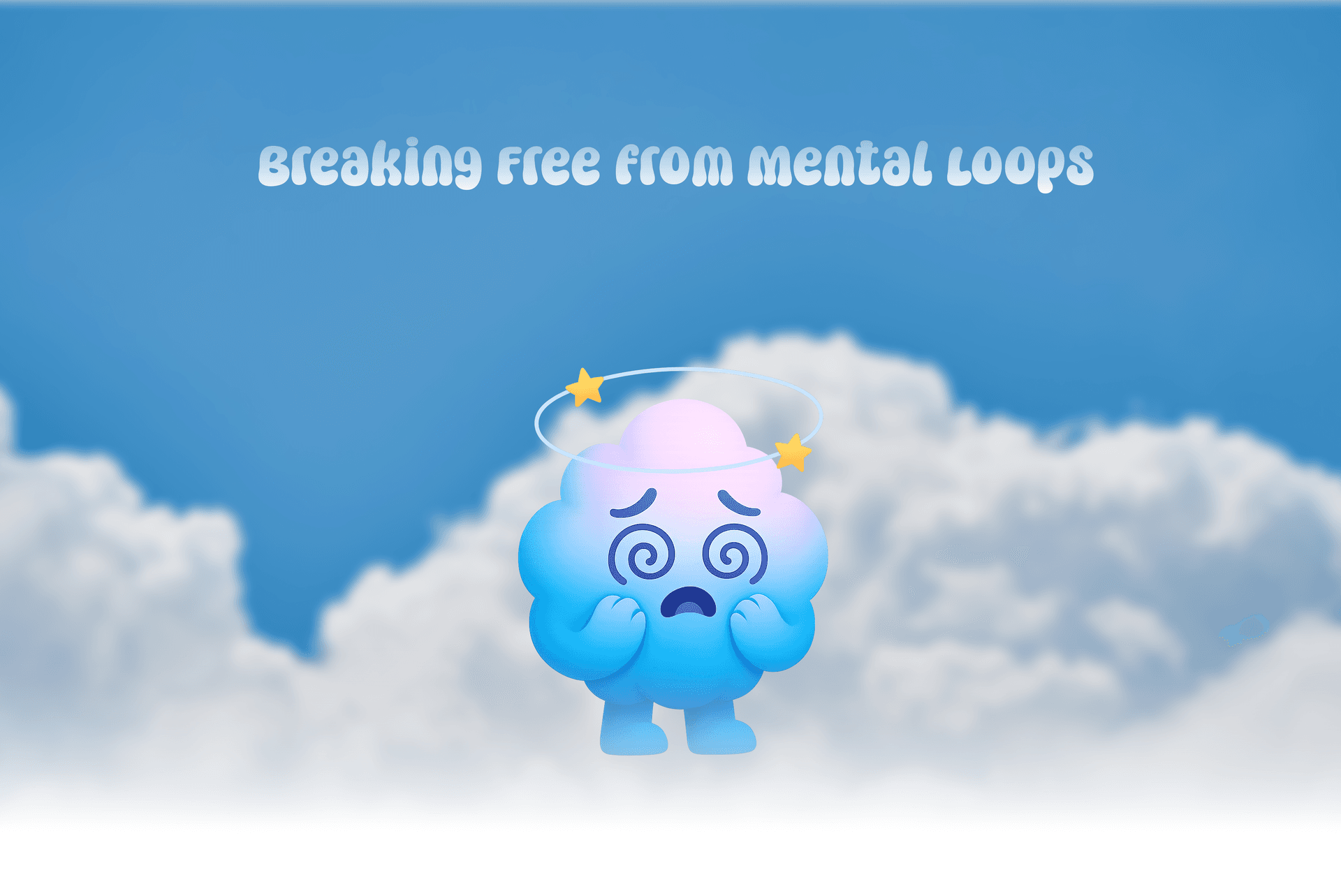Why Your Brain Won't Let Go: A Guide to Breaking Free from Mental Loops
We've all experienced it—sitting at your desk, trying to focus, or attempting to unwind with a movie, and there it is again, that relentless thought.
Whether it's that awkward conversation replaying over, a persistent regret, or a worry spiraling into a future catastrophe, these mental loops, known as rumination, can be a significant source of anxiety and distress.
But what if you could uncover the underlying psychology of these intrusive thoughts and learn how to break free from the cycle?
Let's get into why we keep thinking about that one thing and explore effective strategies, like journaling for anxiety and structured reflection, to help achieve mental clarity.
Understanding Rumination: Unfinished Processing vs. Obsession
The mental loop we experience has a name: rumination.
More than just a fleeting memory, it's a passive focus on a distressing problem.
This habit feels productive but often ends up deepening the psychological groove your thoughts etch in your mind.
The Psychology Behind Rumination: Why We Dwell
Our minds resist unfinished business due to the Zeigarnik effect.
This phenomenon explains our tendency to remember incomplete tasks better than finished ones. Repetitive thoughts are your brain's way of flagging unresolved issues, operating like a persistent alarm system, shouting, "Deal with this now!"
Paradoxically, attempting to banish these thoughts only strengthens them, known as the "ironic monitoring" effect.
Tell your brain "Don't think of a white bear," and that's exactly what it will picture. Suppressing a thought requires constantly monitoring it, keeping it prominently in focus.
Obsession vs. Healthy Reflection: Striking a Balance
Are you just processing, or are you stuck in a loop? Differentiating healthy reflection from harmful rumination and obsession is key.
- •Healthy Reflection focuses on solutions. You analyze past events to learn and move on.
- •Rumination is passive and problem-oriented. It fixates on the feelings of the issue ("Why do I always mess up?"), often linked to anxiety and depression.
- •Obsession involves intrusive thoughts that cause significant distress and may lead to compulsive actions—a hallmark of Obsessive-Compulsive Disorder (OCD).
If your repetitive thoughts lean towards obsession, seeking professional help is essential. For rumination, learning to manage the emotions driving these thoughts is crucial.
The Emotional Roots of Repetitive Thoughts
Repetitive thoughts are rarely solitary; they are often anchored by strong emotions, acting as the fuel for this cognitive engine. The most common emotional fuels for rumination include:
- •Guilt and Shame: These emotions tether you to past actions, making you replay scenes of regret.
- •Grief: Loss prompts your mind to circle back to memories, attempting to process the ensuing void.
- •Anxiety and Fear: Future worries spur your brain into overdrive, trying to preempt negative outcomes and exacerbating anxiety.
Understanding the emotions driving these thoughts is the first step to breaking free. Naming and processing these emotions reduces their hold on you.
Journaling as a Tool for Integration and Relief
A research-backed method for managing rumination and intrusive thoughts is surprisingly simple: write about them. Journaling for anxiety isn't just a venting strategy; it's a tool for cognitive and emotional integration.
The Power of Writing Against Intrusive Thoughts
Transforming a thought from an abstract idea into structured writing creates distance, allowing for clarity. Research shows that expressive writing can significantly decrease symptoms of anxiety and depression by engaging areas of the brain involved in self-reflection and emotional regulation.
Effective Journaling Strategies:
- •Set a Timer: Begin with 10-15 minutes—manageable and non-intimidating.
- •Write Freely: Allow thoughts to flow without worrying about coherence. This is for your eyes only.
- •Focus on Emotions: Explore the emotions behind the thoughts. Ask: "What feeling drives this thought? Where do I feel it physically?"
- •Probe with Questions: "What's the worst-case scenario?" "What's likely to truly happen?" "What evidence supports or contradicts my thoughts?"
Identifying Patterns Through ABY Journals
A structured journaling approach, like the ABY technique (Acknowledge, Breathe, Yield), can enhance introspection by transforming your journal into a mindfulness tool.
The ABY Approach: Recognizing Patterns
- •Acknowledge: Identify the thought and core emotion. "I acknowledge the thought that I'm inadequate for this job, and I feel fear."
- •Breathe: Pause, and take three deep breaths to calm your nervous system.
- •Yield: Rather than fighting or accepting the thought's truth, yield to its presence without judgment, like a passing cloud. Write, "I'm allowing this fearful thought without needing to fix it."
By incorporating the ABY method, you uncover patterns in thoughts and emotions, leading to profound realizations and healing, as in the case of recognizing long-standing fears of abandonment beyond recent events.
Structured Reflection: Letting Thoughts Complete Their Loop
Ironically, allowing yourself to think about pressing thoughts on your terms can resolve them through structured reflection. This involves creating thought "containers" to prevent them from overwhelming you.
Building a Routine for Thought Resolution:
- •Schedule "Worry Time": Allocate 15 minutes daily to engage with persistent thoughts, keeping them from interrupting other activities.
- •Employ the "If-Then" Strategy: As suggested by psychologist Heidi Grant Halvorson, plan responses for recurrent thoughts. "If I think about errors at work, then I'll reflect on my achievements."
- •Visualize a Train Station: Picture thoughts as trains arriving and departing. Not every train requires boarding. Acknowledge them, whether they're freight trains or gentle rides, and allow them to pass without engagement.
Finding mental peace isn't about an empty mind but redefining your relationship with thoughts—acknowledging them as just thoughts, not commands. By understanding mental persistence and applying strategies like journaling and structured reflection, you can neutralize the power of repetitive thoughts and embrace the peace you deserve.
Stay in the know
Receive thoughtful insights on mindful living, delivered with intention.
Continue Your Journey
More reflections to inspire your path



